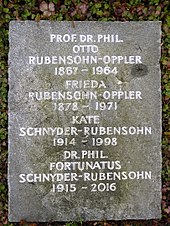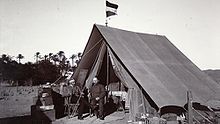Otto Rubensohn
Otto Rubensohn (born November 24, 1867 in Kassel , † August 9, 1964 in Höchenschwand ) was a German classical archaeologist .
Life
Otto Rubensohn was the son of the Jewish businessman and trade judge Hermann Rubensohn (1837-1919) and his wife Rosa (1838-1931). The classical philologist Max Rubensohn was his cousin. After graduating from high school in Kassel in 1887, he studied at the University of Berlin and the University of Strasbourg . In 1892 Rubensohn received his doctorate from Adolf Michaelis in Strasbourg with a thesis on the Mystery Shrines of Eleusis and Samothrace . He remained true to the topic of his dissertation throughout his life. In 1893 he passed the first teaching exams for Latin, Greek, history and German in Berlin and, after completing his military service as a one-year volunteer in Kassel in 1893/1894, did preparatory service at grammar schools in Berlin and Potsdam in 1895/1896. In 1897 he worked at the Victoria High School in Potsdam .
On behalf of the German Archaeological Institute , he excavated on Paros between 1897 and 1899 ( Delion , sanctuaries of Apollon and Asclepius ). From 1899 to 1901 he taught at the Lessing Gymnasium in Berlin.
From 1901 to 1907 Rubensohn led the German Papyrus Cartel's search for papyri in Egypt . With the Elephantine papyri he succeeded in finding an important Aramaic papyri. His excavations in Elephantine brought new insights into the international relations of the city in antiquity . After his return to Germany, Rubensohn became a senior teacher in 1907 (from 1910 with the title of professor) at the Friedrichs-Gymnasium in Breslau . In 1911 he left the Prussian school service and became director of the Pelizaeus Museum in Hildesheim . But at the end of 1914 he resigned from this office because of the associated restrictions on his research activities. The city of Hildesheim thanked the founding director of the museum with the award of a medal of honor. In 1911 he also became a corresponding member of the Academy of Sciences in Göttingen .
When teachers were needed during the First World War , Rubensohn returned to the Berlin school service in 1915. In 1920 he was employed again as a senior teacher or teacher at the Luisengymnasium , switched to the Wilhelms-Gymnasium in 1922 and, after its closure in 1924, to the Prinz-Heinrich-Gymnasium . Rubensohn was extremely popular with the students because of his teaching and broad horizons. From 1916 he also used slide positives for teaching and was a pioneer in this field in teaching. Excursions to the Altes Museum were also part of the class. In 1917 he took part in the excavation of a Dakerburg in Cotzofani at the side of Carl Schuchhardt .
In the spring of 1939 Rubensohn, who retired in 1932, and his wife left Germany at the urging of their daughter, who was studying in Switzerland. He left Germany at a dangerously late point in time and waited even longer to leave than Paul Jacobsthal , with whom he had in common that they did not want to believe that their fatherland would develop into the Nazi coercive state for a long time . His membership in the DAI and the Academy of Sciences in Göttingen ended in the 1930s because of his Jewish origins.

The family went to Basel . Here he had been friends with the ancient historian Felix Staehelin since his early days in Greece , and later he became friends with Ernst Pfuhl . The Rubensohn couple survived this time unscathed, as they received financial support from Mimi Borchardt-Cohen, the widow of Rubensohn's friend Ludwig Borchardt , with whom he had been friends since Rubensohn's time in Egypt. Rubensohn did research at the Basel Archaeological Seminar until he was old. In 1956 he was one of the founding members of the Association of Friends of Ancient Art . In 1958 the association dedicated the second annual issue of its publication Antike Kunst to him . He was also an honorary member of the Archaeological Society of Athens . On his 95th birthday Rubensohn was awarded the Federal Cross of Merit, 1st Class . Rubensohn died at the age of 96 in his holiday resort Höchenschwand. He sold his collection of Graeco-Egyptian cabaret to the Association for the Promotion of the Archaeological Collection of the University of Münster .
Rubensohn made a lasting contribution to the exploration of Paros. Due to the emigration, his complete account of the history and art history of Paros, which was completed in 1938, could not appear in Pauly-Wissowa until 1949 . In addition, Rubensohn was able to provide evidence that the winged goddess of Delos depicts the goddess Artemis and was created by the sculptor Archermos . His monograph on the Apollo sanctuary in Paros, the so-called Delion , was published on Rubensohn's 95th birthday. He also worked with the Parian artists in late Hellenism and at Delian places of worship.
Fonts (selection)
- The Mystery Shrines in Eleusis and Samothrace. Gardener, Berlin 1892, digitized
- Elephantine papyri. With contributions by W. Schubart and W. Spiegelberg. Special edition of Egyptian documents from the Royal Museums in Berlin . Weidmannsche Buchhandlung, Berlin 1907, digitized
- Hellenistic silver device in ancient plaster casts. Festschrift to celebrate the opening of the Pelizaeus Museum, July 29, 1911. Curtius, Berlin 1911
- The Delion of Paros . Steiner, Wiesbaden 1962
literature
- Karl Schefold : Otto Rubensohn in memory. In: Antike Kunst 8, 1965, p. 104.
- Rudolf E. Heymann: Memories of Otto Rubensohn. In: Antike Kunst 22, 1979, p. 110.
- Karl Schefold: Otto Rubensohn . In: Reinhard Lullies , Wolfgang Schiering (Hrsg.): Archäologenbildnisse . Portraits and short biographies of classical archaeologists in the German language . Zabern, Mainz 1988, pp. 166-167.
Web links
- Literature by and about Otto Rubensohn in the catalog of the German National Library
- Otto Rubensohn's personnel sheet in the personnel file of the BIL expert body in the archive database of the Library for Research on Educational History (BBF)
- Otto Rubensohn estate in the Jewish Museum Berlin
| personal data | |
|---|---|
| SURNAME | Rubensohn, Otto |
| BRIEF DESCRIPTION | German classical archaeologist |
| DATE OF BIRTH | November 24, 1867 |
| PLACE OF BIRTH | kassel |
| DATE OF DEATH | August 9, 1964 |
| Place of death | Höchenschwand |
